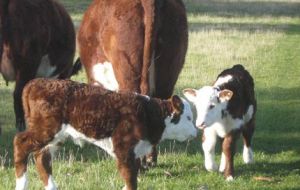MercoPress. South Atlantic News Agency
Insufficient calves and forage threaten Uruguay beef industry
 Uruguay cattle breeds in 14 m. hectares of natural pasture
Uruguay cattle breeds in 14 m. hectares of natural pasture Uruguay which has been breaking beef export records for the last few years is facing growing difficulties in keeping the necessary calves' production level, while the large farmlands dedicated to agriculture keep expanding and forage sowing has been delayed because of lack of sufficient rains.
These are some of the main observations from the latest Ministry of Agriculture, Livestock, Fisheries and Food Statistics report DIEA released this week which also points out that from a statistical point of view "the global high prices cycle is proving to be something longer than what we are used to". "The pregnancy level of cows this year is 10% below the average of our previous statistical reports" which anticipates a future problem and will require an investigation into livestock management practices, said Jose Maria Ferrari head of the Statistics Office. Another worrisome aspect from the statistics report is the apparent flatting out of pasture improvement and forage areas which in the mid term can become a serious problem and have a negative impact on meat and milk production. "Higher input costs plus climate consequences diminished significantly pasture sowing intention", said Ferrari. Regarding land dedicated to agriculture and forestry, the latest reports shows that grains, oilseeds and rice total 800.000 hectares; the booming pulp industry has a supply of 750.000 hectares of woods and dairy farming occupies another 800.000 hectares. Livestock (cattle and sheep) exploitations represent 14 million hectares of natural pastures. An interesting number from the statistics report which goes back to the year 2000 is that at the time 8.900 hectares were dedicated to soybeans. Currently the area ranges between 480.000 and 500.000 hectares according to the latest fall harvest.




Top Comments
Disclaimer & comment rulesCommenting for this story is now closed.
If you have a Facebook account, become a fan and comment on our Facebook Page!